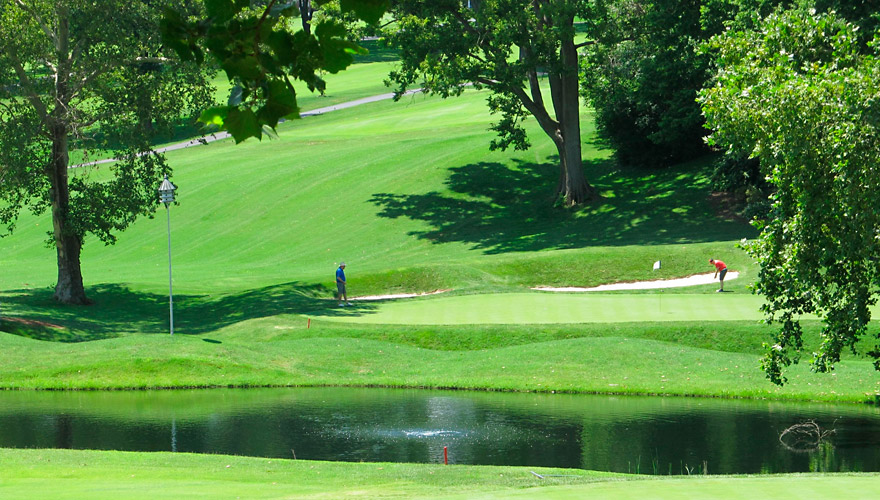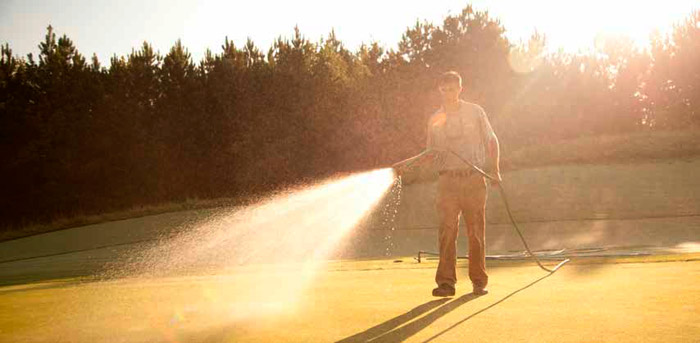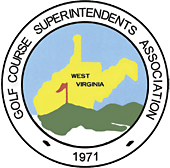Surface Water Management

Although golf courses are typically large properties ranging in size from 60 to 200 acres, they are just one link in a stormwater management chain. Generally, a quantity of stormwater enters the golf course area, supplemented by what falls on the golf course proper, and then the stormwater leaves the golf course. Therefore, golf courses are realistically capable of having only a small impact on major stormwater flow. That impact should be to add only small increments of water over a given period of time. Engineers call this function “detention.”
When golf courses are designed and built, their drainage capability concept is guided by an average rainfall event of a given frequency. For example, typically, a golf course drainage system is designed to detain a two- or five-year rain event. In other words, when that rain event happens, the golf course will be able to be reasonably drained in a matter of hours, as excess water not absorbed by the soil flows through the drainage system, is temporarily held, and finally leaves the property. In some instances, golf courses and other recreational facilities are mandated to be designed to handle a 20-, 50- or 100-year rain event, which means the golf course must detain more water for perhaps a longer period of time. This ability to detain large amounts of water requires accurate engineering and extensive construction to prevent physical or financial damage to the facility.
Best Management Practices are intended to prolong the detention process as long as practical, harvest as much of the stormwater in surface or underground storage as reasonable, and to improve the quality of water leaving the property when possible.
Stormwater Capture
Principles
- When the golf course is properly designed, rain and runoff captured in water hazards and stormwater ponds may provide most or all of the supplemental water necessary under normal conditions, though backup sources may be needed during drought conditions.
- Capture systems should be considered part of the overall treatment.
- Stormwater capture is desirable where the lowest quality of water is needed to conserve potable water, maintain hydrologic balance, and improve water treatment.
- This practice uses natural systems to cleanse and improve water treatment.
Best Management Practices
- Install berms and swells to capture pollutants and sediments from runoff before it enters the irrigation storage pond.
- Monitor pond water level for water loss (seepage) to underground systems. If seepage is occurring, it may be necessary to line or seal the pond or install pumps to relocate water.
- Install water-intake systems that use horizontal wells placed in the subsoil below the storage basin; use a post pump to filter particulate matter.
- A backup source of water should be incorporated into the management plan.
- Inspect irrigation pumps, filtration systems, conveyances and control devices to prevent/correct system issues.
Regulatory Considerations
Principle
Course owners and superintendents should investigate regulatory requirements that apply to the golf facility to protect surface and groundwater quality.
Best Management Practices
- Aquatic management of plants may be regulated under construction permitting and regulatory licensing requirements. Consult with federal, state, and local water management agencies before managing golf course lakes and wetland areas.
- Consult with federal, state, and local water management agencies, and/or consult an approved management plan before performing cultural practices: fertilization, installation of plants, hand removal of plants, or mechanical harvesting.
- The introduction of aquatic triploid grass carp, biological controls, aeration, and chemical controls (herbicide/algaecide) must be approved and monitored according to permit and licensing protocols and compliance.
- The disposal of sediments from surface water ponds (stormwater detention) may be subject to regulation.
- Golf course management may be affected by Total Maximum Daily Loading (TMDL), mitigation, and watershed basin management action plans (BMAP).
- Wetlands are protected areas; consult with federal and state agencies before altering natural aquatic areas.
- Constructed wetlands should have an impervious bottom to prevent groundwater contamination.
- Studies of water supplies are needed for irrigation systems, including studies of waterbodies or flows on, near, and under the property to properly design a course’s stormwater system and water features to protect water resources.
Water Quality Protection
Principle
- An aquatic plant management strategy should address the intended uses of the waterbody to maintain water quality. Proper documentation of the site’s physical attributes and location, the presence of invasive or weedy species, aesthetics, watershed and groundwater assessments, and other environmental considerations.
- Only licensed individuals or contractors should be allowed to select and apply aquatic pesticides.
Best Management Practices
- Accommodate natural lake processes in the construction of lakes and ponds; include herbaceous and woody vegetation and emergent and submergent shoreline plants to reduce operational costs.
- Use integrated pest management (IPM) strategies and native or naturalized vegetation wherever practical.
- Apply appropriate herbicides to minimize damage to non-target littoral plantings.
- Maintain a narrow band of open water at the pond edge to control the expansion of plants into more desirable littoral plantings.
- Use appropriate aquatic herbicides to prevent turfgrass injury and to protect water quality and wildlife habitat.
- Irrigation should not directly strike or run off to waterbodies, and no-fertilization buffers should be maintained along water edges.
- Outline goals and priorities to guide the development of the BMP necessary to support the lake/aquatic management plan.
- Superintendents should monitor designated waters in their area for the persistence of toxic herbicides and algaecides in the environment.
- Secondary environmental effects on surface water and groundwater from the chemical control of vegetation should be monitored and recorded.
- Apply fertilizer and reclaimed (reuse) irrigation/fertigation appropriately to avoid surface water and groundwater contamination.
- Apply copper products per label instructions to reduce the risk of impairing water quality and causing negative biological impacts.
- Identify position of property in relation to its watershed.
- Identify overall goals and validate concerns of the local watershed.
- Identify surface water and flow patterns.
- Indicate stormwater flow as well as existing and potential holding capacity.
- Indicate impervious surfaces, such as buildings, parking lots, or pathways.
- Indicate major drainages and catch basins that connect to local surface water bodies.
- Identify and understand depth to water tables and soil types.
- Locate and protect wellheads.
Dissolved Oxygen
Principles
- Every golf course should have a plan to monitor the state of the environment and the effects the golf course may be having on the environment.
- Monitoring is used to determine whether outside events are changing the water quality entering the golf course, or whether the golf course is having a positive, neutral, or negative effect on water quality. It also provides a body of evidence on the golf course’s environmental impact.
- A water-quality monitoring plan should be prepared to ensure the ongoing protection of groundwater and surface-water quality after construction has been completed. The same sites should be monitored during the preconstruction phase, although the monitoring plan can be modified based on site-specific conditions.
- Sampling parameters are determined based on golf course operation and basin-specific parameters of concern (these may be identified by local/state Total Maximum Daily Load (TMDL) Programs). Typically, samples should be analyzed for nutrients, pH and alkalinity, sediments, and suspended solids, dissolved oxygen (DO), heavy metals, and any pesticides expected to be used on the golf course.
- Ongoing, routine water sampling provides meaningful trends over time. A single sample is rarely meaningful in isolation.
- Post-construction sampling of surface-water quality should begin with the installation and maintenance of golf course turf and landscaping. Samples should be collected a minimum of three times per year.
- If there is no discharge on the scheduled sample date, samples should be taken during the next discharge event.
- Post-construction surface-water quality sampling should continue through the first three years of operation and during the wet and dry seasons every third year thereafter, provided that all required water-quality monitoring has been completed and the development continues to implement all current management plans. It may also be wise to sample if a significant change has been made in course operation or design that could affect nearby water quality.
- Sampling parameters should be determined based on golf course operation and any basin-specific parameters of concern (identified by the TMDL program or local regulators).
- The purpose of quality assurance/quality control (QA/QC) is to ensure that chemical, physical, biological, microbiological, and toxicological data are appropriate and reliable. Data should be collected and analyzed using scientifically sound procedures.
- However, even if the data are only for proprietary use and are not reported to any regulatory agency, it is strongly recommended that a certified laboratory be used and all QA/QC procedures followed.
- Golf course management must have good data to make good decisions. If a golf course should ever want to produce data for an agency or go to court to defend the facility from unwarranted charges, those data must meet QA/QC standards to be defensible as evidence.
Best Management Practices
- Establish DO thresholds to prevent fish kills (occur at levels of 2 ppm), for example, use artificial aeration (diffusers).
- Reduce stress on fish; keep DO levels above 3 ppm.
- Select algaecides containing hydrogen peroxide instead of copper or endothall to treat high populations of phytoplankton.
- Use IPM principles to limit excess use of pesticides.
- Spot-treat filamentous algae or frequently remove algae by hand to prevent lowering oxygen concentrations in water.
- Use dyes and aeration to maintain appropriate light and DO levels.
- Apply algaecides to small areas to prevent fish mortality; do not treat the entire pond at once.
- Coordinate construction/renovation activities to minimize the amount of disturbed area and possible risk of contamination via runoff.
- Plan construction/renovation activities in phases to limit soil disruption and movement.
- Sod, spring, or reseed bare or thinning turf areas.
- Mulch areas under tree canopies to cover bare soil.
- Avoid the use of trimmers along the edge of the water body.
- Mow lake and pond collars at a higher height to slow and filter overland flow to waterbodies.
- Remove excess sediments to reduce irrigation system failures.
- Treat dredged materials as a toxic substance. Avoid contact with turf.
- Locate littoral shelves at the pond’s inlets and outlets to reduce problems with the playability and maintainability of a water hazard.
- Seek professional assistance from an environmental specialist to design an appropriate water sample collection strategy.
- Determine which sites will be analyzed, and use reputable equipment and qualified technicians.
- Demonstrate responsible land and water use practices based on water data.
- Define data values appropriately based on the associated BMP used to protect water quality.
- Record observations of fish, wildlife, and general pond conditions.
Aquatic Plants
Principles
- Phytoplankton, which give water its green appearance, provide the base for the food chain in ponds. Tiny animals called zooplankton use phytoplankton as a food source.
- Large aquatic plants (aquatic macrophytes) can grow rooted to the bottom and supported by the water (submersed plants), rooted to the bottom or shoreline and extended above the water surface (emersed plants), rooted to the bottom with their leaves floating on the water surface (floating-leaved plants), or free-floating on the water surface (floating plants). Different types of aquatic macrophytes have different functions in ponds.
- Plant life growing on littoral shelves may help to protect receiving waters from the pollutants present in surface water runoff, and a littoral shelf is often required in permitted surface water-retention ponds. Floating plants suppress phytoplankton because they absorb nutrients from the pond water and create shade.
- The use of aquatic plants to improve the appearance of a pond (aquascaping) can be included as part of the overall landscape design.
- Ponds may be constructed on golf courses strictly as water hazards or for landscape purposes, but they often have the primary purpose of drainage and stormwater management, and are also often a source of irrigation water.
Best Management Practices
- Properly designed ponds with a narrow fringe of vegetation along the edge are more resistant to problems than those with highly maintained turf.
- In ponds with littoral plantings, problem plants should be selectively controlled without damaging littoral shelves.
- Encourage clumps of native emergent vegetation at the shoreline.
- A comprehensive lake management plan should include strategies to control the growth of nuisance vegetation that can negatively affect a pond’s water quality and treatment capacity.
- Frequently remove filamentous algae by hand and/or frequently apply algaecide to small areas of algae (spot treatment).
- To reduce the risk of oxygen depletion, use an algaecide containing hydrogen peroxide instead of one with copper or endothall.

Human Health Concerns
Principles
- The use of pesticides should be part of an overall pest management strategy that includes biological controls, cultural methods, pest monitoring, and other applicable practices, referred to altogether as IPM.
- Address areas where standing water may provide habitat for nuisance organisms.
Best Management Practices
- Use IPM principles to address insects that may pose a hazard to human health.
- Drain areas of standing water during wet seasons to reduce insect populations.
- Use Bacillus thuringiensis (Bt) products according to label directions to manage waterborne insect larvae.
Floodplain Restoration
Principles
- Reestablishment of natural water systems helps mitigate flooding and control stormwater.
- Address high sediment and nutrient loads and vertical and lateral stream migration causing unstable banks, flooding, and reductions in groundwater recharge.
- Land use decisions and engineering standards must be based on the latest research science available.
Best Management Practices
- Install stream buffers to restore natural water flows and flooding controls.
- Install buffers in play areas to stabilize and restore natural areas that will attract wildlife species.
- Install detention basins to store water and reduce flooding at peak flows.
Stormwater, Ponds, and Lakes
Stormwater is the conveying force behind what is called nonpoint source pollution. Nonpoint pollution, which is both natural and caused by humans, comes not from a pipe from a factory or sewage treatment plant, but from daily activity. Pollutants commonly found in stormwater include the microscopic wear products of brake linings and tires; oil; shingle particles washed off roofs; soap, dirt, and worn paint particles from car washing; leaves and grass clippings; pet and wildlife wastes; lawn, commercial, and agricultural fertilizers; and pesticides.
Principles
- The control of stormwater on a golf course is more than just preventing the flooding of the clubhouse, maintenance, and play areas. In addition to controlling the amount and rate of water leaving the course, it involves storing irrigation water, controlling erosion and sediment, enhancing wildlife habitat, removing waterborne pollutants, and addressing aesthetic and playability concerns.
- Most golf courses plan their lakes and water hazards to be a part of the stormwater control and treatment system. However, natural waters of the state cannot be considered treatment systems and must be protected.
- Lakes and ponds may also be used as a source of irrigation water.
- It is important to consider these functions when designing and constructing the ponds. Peninsular projections and long, narrow fingers may prevent mixing. Ponds that are too shallow may reach high temperatures, leading to low oxygen levels and promoting algal growth and excess sedimentation.
- Stormwater treatment is best accomplished by a treatment train approach, in which water is conveyed from one treatment to another by conveyances that themselves contribute to the treatment.
- Source controls are the first car on the BMP treatment train. They help to prevent the generation of stormwater or introduction of pollutants into stormwater. The most effective method of stormwater treatment is not to generate stormwater in the first place, or to remove it as it is generated.
Best Management Practices
- Install swales and slight berms where appropriate around the water’s edge, along with buffer strips, to reduce nutrients and contamination.
- Design stormwater treatment trains to direct stormwater across vegetated filter strips (such as turfgrass), through a swale into a wet detention pond, and then out through another swale to a constructed wetland system.
- Ensure that no discharges from pipes go directly to water.
- Eliminate or minimize directly connected impervious areas.
- Use vegetated swales to slow and infiltrate water and trap pollutants in the soil, where they can be naturally destroyed by soil organisms.
- Use depressed landscape islands in parking lots to catch, filter, and infiltrate water, instead of letting it run off. When hard rains occur, an elevated stormwater drain inlet allows the island to hold the treatment volume and settle out sediments, while allowing the overflow to drain away.
- Maximize the use of pervious pavements, such as brick or concrete pavers separated by sand and planted with grass. Special high-permeability concrete is available for cart paths or parking lots.
- Disconnect runoff from gutters and roof drains from impervious areas, so that it flows onto permeable areas that allow the water to infiltrate near the point of generation.
- Golf course stormwater management should include “natural systems engineering” or “soft engineering” approaches that maximize the use of natural systems to treat water.
- Ensure that no discharges from pipes go directly to water.
- Use a treatment train approach.
- Institute buffers and special management zones.




